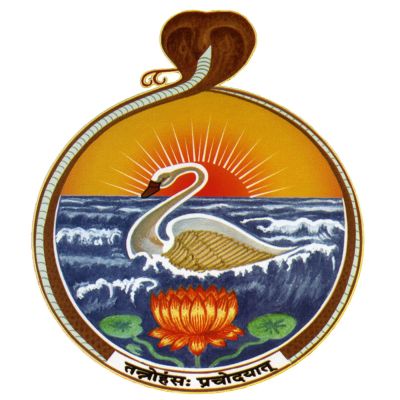Swami Tattwamayananda’s class on Srimad Bhagavad Gita is held at the Vedanta Society of Northern California, San Francisco (founded by Swami Vivekananda in 1900) on Friday evenings in the First Universal Hindu Temple in the West (founded by Swami Trigunatitananda in 1905). Classes are held on Friday night at 7:30 pm. All are most welcome.The Srimad Bhagavad Gita is the most important spiritual classic of Hinduism.Swami Tattwamayananda, currently the Minister of the Vedanta Society of Northern California, San Francisco, (originally founded by Swami Vivekananda in 1900) served in various centers of the Ramakrishna Order in India as editor, publisher, and teacher of Sanskrit, Advaitic texts such as Sri Shankaracharya's commentaries on the 'Prasthanatraya' (the fundamental Sanskrit texts of Vedanta philosophy), Buddhism and Indian philosophy. He underwent traditional training in Hindu scriptures, Sanskrit, Vedic and Vedantic literature for many years, from his early days...
https://www.spreaker.com/show/srimad-bhagavad-gita_1
92 - God as the Supreme Principle Behind Everything | Swami Tattwamayananda
Summary:
9th chapter: verses 17, 19, 20, 21, 22. 18th chapter: verse 66
17th verse: “I am the father of this world, the mother, the upholder, the origin, and the purifier. I am the one thing to be known. I am omkara and I am the vedas.”
“I” here refers to the all-pervading divine reality, which acts as the protecting, nourishing, upholding principle. It is this divine reality that is to be realized.
Omkara, as a sound-symbol, represents the totality and oneness of existence, and the essence of the Vedas. It represents the unified universe consisting of the three worlds of existence: below the earth, upon the earth, and celestial level. In monotheistic religions, it corresponds to the unity of all divine personifications – Brahma, Vishnu, and Maheshvara. It is the beginning, middle, and end of all human speech. In Patanjali Yoga Sutra, it is described as the name of the Lord.
Gayatri mantra has 24 letters and is a very sublime mantra. Om is an integral part of Gayatri mantra. It invokes the effulgent divine reality, that is present everywhere, and it takes one beyond the three levels of existence - towards the transcendental.
The 17th verse puts a very high philosophical ideal – oneness and unity of human family – in the language of everyday human relations.
19th verse: “As the sun, I am the heat. I withhold and send forth rain. I am immortal and also dead. I am also the being and the non-being.”
The 19th verse uses the sublime technique of using language that seems contradictory to point to its transcendental meaning. A poet in Vedantic tradition is one who is able to see far into things and bring out the grandeur of the subject he is writing on.
Ramanuja in his commentary on this verse says: “I provide both heat and rain. I am the source of energy that sustains human life. I am the sequence in the seasons. I am the supreme principle behind the harmonious existence of life in this world. I am the immortal principle behind that which is immortal. I am the finite principle behind that which is finite.”
One cannot transcend death at the physical level. When we realize our true nature and its immortal dimension, we transcend death. Brihadaranyaka Upanishad has a profound dialog between Yajnavalkya and Maitreyi on the topic of immortality.
Both existence and non-existence are non-distinct from the divine reality. Nothing can be excluded from that reality, not even the concept of evil. Vedanta does not define God as the totality of all positive virtues. It replaces the doctrine of evil with the doctrine of ignorance. As we evolve, so called evil is understood to be a stage where we experience something due to our lack of the highest spiritual enlightenment. At the highest level, all secular activities become spiritualized.
Swami Vivekananda said: “Worshipping the terrible is a sign of sannyasa (mendicant).” A Mendicant is a person who accepts everything. For him, the totality alone exists – it includes good and bad. But, at a spiritually evolved stage, he automatically accepts only the good – he cannot harm others, as described in the 18th chapter of Bhagavad Gita.
In the 66th verse of the 18th chapter, Lord Krishna describes the spiritual psychology of self-surrender. He says to Arjuna: “Give up all distinctions between dharma and adharma. Attach your will to God’s will. Attach your mind and emotions to the divine. Then you will naturally choose the right dharma.”
20th and 21st verse: There are those who perform rituals for material prosperity and long life. They are also worshipping the same divine Lord, but not in its most sublime sense. They are at the beginning of spiritual life. They go to heaven, and once their spiritual merits are exhausted, they return to the world. For them, the cycle of birth and death continues.
22nd verse: “People who meditate on God as not separate, who worship Him in all beings, who are always engaged in that divine pursuit – for such people, I carry what they lack, and preserve what they already have.”
Yoga in this verse means helping you attain what you have not already attained. Kshema in this verse means preserving what you have already attained.
Lord Krishna makes a big promise in this verse. “If you do God’s work, God will work for you.” We experience this in our lives. When we do good, noble deeds without selfish motives, then some of our problems are automatically solved. A noble act done for the good of others is an act of worship and generates spiritual energy.
The story of Lord Krishna and Sudama illustrates this promise. When Sudama gave parched rice to Lord Krishna, it returned to him as prosperity in an invisible way.”
